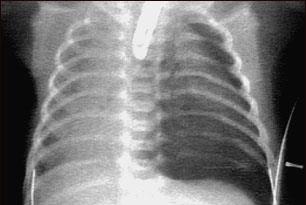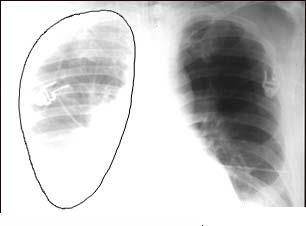Collapsed lung
Content
When to contact a medical professional
A collapsed lung, or pneumothorax, is the collection of air in the space around the lungs. This buildup of air puts pressure on the lung, so it cannot expand as much as it normally does when you take a breath.
CAUSES
A collapsed lung occurs when air escapes from the lung and fills up the space outside of the lung, inside the chest. It may be caused by a gunshot or knife wound to the chest, rib fracture, or certain medical procedures.

In some cases, a collapsed lung occurs without any cause. This is called a spontaneous pneumothorax. A small area in the lung that is filled with air (bleb) can break open, sending air into the space around the lung.
Tall, thin people and smokers are more likely to have a collapsed lung.
The following lung diseases also increase your risk for a collapsed lung:
SYMPTOMS
Common symptoms of a collapsed lung include:
- Sharp chest pain, made worse by a deep breath or a cough
- Shortness of breath
A larger pneumothorax will cause more severe symptoms, including:
- Bluish color of the skin caused by lack of oxygen
- Chest tightness
- Easy fatigue
- Rapid heart rate
Other symptoms that can occur with a collapsed lung include:
EXAMS AND TESTS
There are decreased or no breath sounds on the affected side when heard through a stethoscope. You may have low blood pressure.
Tests include:

TREATMENT
A small pneumothorax may go away on its own. You may only need oxygen and rest.
The doctor may use a needle to pull the extra air out from around the lung so it can expand more fully. You may be allowed to go home if you live near the hospital.
If you have a large pneumothorax, a chest tube will be placed between the ribs into the space around the lungs to help drain the air and allow the lung to re-expand.
The chest tube can be left in place for several days. You may need to stay in the hospital. However, you may be able to go home if a small chest tube is used.
Some patients with a collapsed lung need extra oxygen.
Lung surgery may be needed to treat your pneumothorax or to prevent future episodes. The area where the leak occurred may be repaired. Sometimes, a special chemical is placed into the area of the collapsed lung. This chemical causes a scar to form. This procedure is called pleurodesis.
OUTLOOK (PROGNOSIS)
If you have a collapsed lung, you are more likely to have another one in the future if you:
- Are tall and thin
- Continue to smoke
- Have had two collapsed lungs in the past
How well you do after having a collapsed lung depends on what caused it.
POSSIBLE COMPLICATIONS
- Another collapsed lung in the future
- Shock
WHEN TO CONTACT A MEDICAL PROFESSIONAL
Call your health care provider if you have symptoms of a collapsed lung, especially if you have had one before.
PREVENTION
There is no known way to prevent a collapsed lung, but you can decrease your risk by not smoking.
Source: http://www.nlm.nih.gov/medlineplus/ency/article/000087.htm

